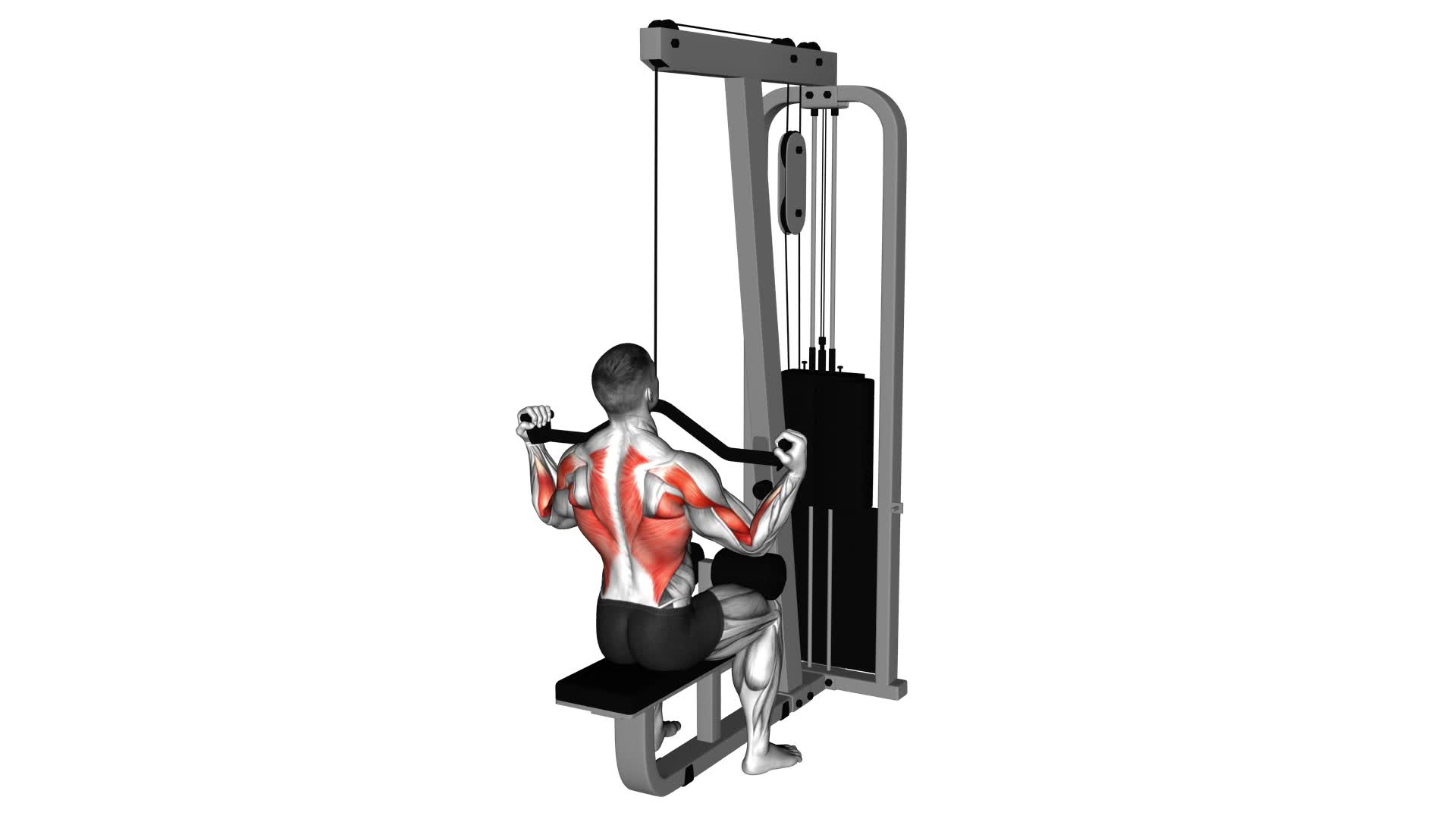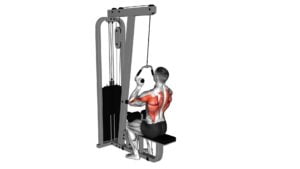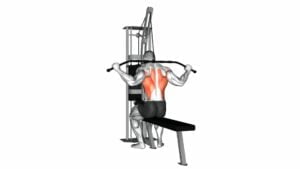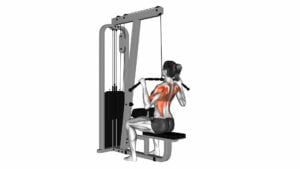Cable Neutral Grip Wide Pulldown (VERSION 2) – Video Exercise Guide & Tips

Are you looking to strengthen your upper body and improve your posture?
Watch This Exercise Video
The cable neutral grip wide pulldown (version 2) is a fantastic exercise to add to your routine.
In this video exercise guide, we'll show you the proper equipment setup, correct grip positioning, and the starting position and execution.
We'll also share common mistakes to avoid, tips for increasing intensity, and variations and progressions.
Get ready to take your workouts to the next level!
Key Takeaways
- Proper equipment setup and grip positioning are essential for an effective Cable Neutral Grip Wide Pulldown exercise.
- Maintaining proper hand placement throughout the exercise enhances grip strength and engages multiple back muscles.
- Form, technique, and avoiding common mistakes such as excessive wrist bending and using momentum are crucial for optimal results and reducing the risk of injury.
- Cable Neutral Grip Wide Pulldown targets the latissimus dorsi (lats) primarily, but also engages other muscles such as the biceps, rhomboids, and rear deltoids to a lesser extent.
Proper Equipment Setup
To properly set up the equipment for the Cable Neutral Grip Wide Pulldown, you'll need to attach the cable handle to the pulldown machine. This exercise requires the following equipment requirements:
- A pulldown machine with an attached cable
- A cable handle
- Appropriate weight plates
Start by adjusting the seat height so that your thighs are parallel to the ground when sitting. Next, position yourself on the seat with your back straight and your feet flat on the ground.
Grab the cable handle with a neutral grip, palms facing each other, and make sure your hands are shoulder-width apart. Keep your elbows slightly bent and your shoulders relaxed. Engage your core and lean back slightly while maintaining an upright posture. This will help you to stabilize your body during the exercise.
It's important to maintain proper body positioning throughout the movement to target the muscles effectively.
Now you're ready to begin the Cable Neutral Grip Wide Pulldown exercise with the correct equipment setup and body positioning.
Correct Grip Positioning
To ensure proper execution of the Cable Neutral Grip Wide Pulldown, it's crucial to pay attention to your hand placement.
The correct grip positioning plays a significant role in optimizing the effectiveness of this exercise.
Hand Placement Importance
Optimal hand placement is crucial for ensuring proper grip positioning during the Cable Neutral Grip Wide Pulldown exercise. The position of your hands on the cable attachment greatly affects the benefits you can derive from this exercise.
By placing your hands in the correct position, you can enhance your grip strength and maximize the effectiveness of the workout. When you grip the bar with your palms facing each other and your thumbs wrapped around, you engage multiple muscle groups in your back, including the latissimus dorsi, rhomboids, and trapezius.
This grip also helps to stabilize your shoulders and reduce strain on your wrists. By maintaining a firm grip, you can improve your overall pulling strength and develop a stronger back.
Remember to focus on maintaining proper hand placement throughout the exercise to get the most out of your Cable Neutral Grip Wide Pulldown.
Form and Technique
Place your hands in the correct position to ensure proper grip positioning during the Cable Neutral Grip Wide Pulldown exercise. The correct grip is essential for maintaining stability and maximizing the benefits of this exercise.
To achieve the correct grip, start by grabbing the handles with an overhand grip, palms facing down. Your hands should be positioned slightly wider than shoulder-width apart. Avoid the common error of gripping the handles too tightly, as this can lead to excessive strain on the wrists and forearms. Additionally, make sure to maintain a neutral wrist position throughout the movement.
The benefits and advantages of using the correct grip positioning include improved targeting of the upper back muscles, increased strength and muscle development, and reduced risk of injury. Focus on maintaining good form and technique to optimize your results.
Avoiding Common Mistakes
Make sure you grip the handles correctly during the Cable Neutral Grip Wide Pulldown exercise to avoid common mistakes. Here are some tips for improvement:
- Maintain a neutral grip: Hold the handles with your palms facing each other, thumbs pointing upward. This grip helps target the muscles in your back effectively.
- Avoid excessive wrist bending: Keep your wrists in a straight and relaxed position throughout the exercise. Bending your wrists excessively can lead to discomfort and potential injuries.
- Engage your back muscles: Focus on using your back muscles to pull the handles down, rather than relying on your arms or shoulders. This will ensure that you're getting the most out of the exercise and targeting the correct muscle groups.
- Control the movement: Avoid using momentum or jerking motions to perform the pulldown. Instead, initiate the movement from your back muscles and maintain a controlled tempo throughout.
Starting Position and Execution
To execute the Cable Neutral Grip Wide Pulldown correctly, it's important to focus on proper form techniques and engage the targeted muscles effectively.
Maintaining a neutral grip and positioning your hands wide apart on the cable bar will help activate the muscles in your back, particularly the latissimus dorsi.
Proper Form Techniques
Start by positioning yourself on the cable machine with a neutral grip and your hands slightly wider than shoulder-width apart. To ensure proper form during the Cable Neutral Grip Wide Pulldown exercise, follow these techniques:
- Maintain a straight posture throughout the movement, avoiding excessive leaning or arching of the back.
- Engage your core muscles to stabilize your body and prevent swinging.
- Pull the cable down towards your chest, focusing on squeezing your shoulder blades together.
- Slowly return to the starting position, extending your arms fully without allowing the weight stack to touch.
Proper form is crucial for maximizing the benefits of the exercise and minimizing the risk of injury. By maintaining the correct technique, you can effectively target the muscles in your back, including the latissimus dorsi, rhomboids, and trapezius.
Muscles Targeted
Engage your back muscles by performing the Cable Neutral Grip Wide Pulldown exercise with proper form and technique.
This exercise primarily targets the latissimus dorsi, or lats, which are the large muscles in your back responsible for pulling movements.
By using a neutral grip and a wide hand position, you specifically target the upper and outer portion of your back.
Additionally, this exercise also engages the biceps, rhomboids, and rear deltoids to a lesser extent.
The Cable Neutral Grip Wide Pulldown is beneficial for improving back strength, posture, and overall upper body stability.
If you don't have access to a cable machine, alternative exercises that target the same muscles include bent-over rows, lat pulldowns, and pull-ups.
Remember to always use proper form and technique to maximize the benefits and minimize the risk of injury.
Common Mistakes to Avoid
You should avoid these common mistakes when performing the Cable Neutral Grip Wide Pulldown to ensure proper form and maximize results. Here are some tips on how to improve your cable pulldown form:
- Using excessive momentum: Avoid swinging or jerking your body during the exercise. This not only reduces the effectiveness of the movement but also increases the risk of injury. Instead, focus on maintaining control and engaging the targeted muscles throughout the entire range of motion.
- Pulling with your arms: Many people make the mistake of relying solely on their arms to perform the pulldown. Remember, this exercise primarily targets the muscles in your back. To improve your form, initiate the movement by squeezing your shoulder blades together and engaging your back muscles before pulling the bar down.
- Arching your back: Keep your back straight and avoid excessive arching during the pulldown. Arching not only reduces the activation of your back muscles but also places unnecessary strain on your lower back. Maintain proper posture throughout the exercise.
- Gripping the bar too tightly: While it's important to have a secure grip, gripping the bar too tightly can limit your range of motion and prevent the proper engagement of your back muscles. Maintain a relaxed but firm grip on the bar to allow for a full and effective movement.
By avoiding these common mistakes and focusing on proper form, you can enhance the effectiveness of your Cable Neutral Grip Wide Pulldown.
Now, let's move on to the next section where we'll discuss tips for increasing the intensity of this exercise.
Tips for Increasing Intensity
To increase the intensity of the Cable Neutral Grip Wide Pulldown, incorporate progressive overload by gradually increasing the weight resistance. This means adding more weight to the machine as you become stronger. Increasing resistance is essential for challenging your muscles and promoting growth.
Start by selecting a weight that allows you to perform the exercise with proper form and control. Once you can comfortably complete the recommended number of repetitions with that weight, it's time to progress. Gradually add small increments of weight, such as 5-10 pounds, to continue challenging your muscles.
In addition to increasing resistance, you can also incorporate advanced modifications to further intensify the exercise. One option is to perform the pulldown with a slower tempo, focusing on a controlled and deliberate movement. This will increase the time under tension and engage the muscles for a longer duration. Another option is to use resistance bands along with the cable machine. Attaching the bands to the bar and pulling against their resistance will provide an extra challenge for your muscles.
By gradually increasing the weight resistance and incorporating advanced modifications, you can effectively increase the intensity of the Cable Neutral Grip Wide Pulldown. These strategies will help you continue progressing and reaching new levels of strength and muscle development.
Now let's move on to the next section to explore variations and progressions of the Cable Neutral Grip Wide Pulldown.
Variations and Progressions
One way to vary and progress the Cable Neutral Grip Wide Pulldown is by incorporating different grip positions. This allows you to target different muscles and add variety to your workout routine. Here are four grip variations you can try:
- Wide Grip: Place your hands wider than shoulder-width apart on the bar. This targets the outer back muscles, helping to create a wider and more defined back.
- Close Grip: Bring your hands closer together, slightly narrower than shoulder-width apart. This grip emphasizes the middle back muscles, giving you a more balanced and sculpted look.
- Underhand Grip: Hold the bar with your palms facing up. This grip variation engages the biceps more, giving you a stronger and more defined upper arm.
- Overhand Grip: Hold the bar with your palms facing down. This grip primarily targets the lats, helping to develop a strong and wide back.
In addition to these grip variations, you can also incorporate other exercises such as barbell rows and resistance band variations to further progress your Cable Neutral Grip Wide Pulldown. Barbell rows work similar muscles and can be used as a progression exercise to challenge your back strength. Resistance band variations, such as seated rows using a resistance band, can add a different type of resistance and help you continue to build strength and muscle.
Frequently Asked Questions
How Many Sets and Reps Should I Do for the Cable Neutral Grip Wide Pulldown (Version 2)?
You should perform the cable neutral grip wide pulldown (version 2) with a specific number of sets and reps to maximize its benefits.
To determine the ideal sets and reps for you, consider factors such as your fitness level, goals, and any specific instructions from your trainer or healthcare professional.
It's important to note that if you have a shoulder injury, you should consult with a medical professional to ensure this exercise is safe for you to perform.
Can I Perform This Exercise if I Have a Shoulder Injury?
If you have a shoulder injury, you may need to modify the cable neutral grip wide pulldown exercise.
It's important to prioritize your safety and avoid aggravating your injury.
Consult with a healthcare professional or a qualified trainer who can guide you on how to adapt the exercise to suit your needs.
They can provide you with specific modifications or alternative exercises that will help you strengthen your back muscles without putting excessive strain on your injured shoulder.
Should I Use a Weightlifting Belt While Doing This Exercise?
When doing the Cable Neutral Grip Wide Pulldown exercise, you might wonder if using a weightlifting belt is necessary.
While a weightlifting belt can provide support and stability to your core, it isn't essential for this exercise. However, if you have a history of back issues or prefer the added support, a weightlifting belt can be beneficial.
Alternatively, you can focus on maintaining proper form and engaging your core muscles to ensure stability during the exercise.
Can I Substitute the Cable Machine With Resistance Bands for This Exercise?
Yes, you can substitute the cable machine with resistance bands for this exercise. Using resistance bands offers several benefits, such as increased flexibility, portability, and versatility. They allow you to target the same muscle groups as the cable machine, providing a challenging workout.
Resistance bands also provide constant tension throughout the movement, helping to improve muscle strength and endurance. So, feel free to use resistance bands as an effective alternative to the cable machine for the Cable Neutral Grip Wide Pulldown exercise.
Is It Normal to Feel Some Discomfort in My Forearms While Performing the Cable Neutral Grip Wide Pulldown (Version 2)?
Feeling some discomfort in your forearms during the cable neutral grip wide pulldown (version 2) is normal. This exercise targets multiple muscles, including your forearms.
However, if the discomfort is excessive or painful, it may indicate improper form or too much weight. Make sure you have a proper grip and technique, and adjust the weight accordingly.
If the discomfort persists, consider trying variations of the cable neutral grip wide pulldown exercise or consulting a fitness professional for guidance.
Conclusion
In conclusion, the cable neutral grip wide pulldown (version 2) is an effective exercise that targets the back muscles, specifically the lats. By following the proper equipment setup, correct grip positioning, and starting position, you can perform this exercise with precision and efficiency.
Avoid common mistakes and utilize tips for increasing intensity to maximize the benefits of this exercise. Additionally, variations and progressions can be added to challenge yourself as you progress in your fitness journey.

Author
Years ago, the spark of my life’s passion ignited in my mind the moment I stepped into the local gym for the first time. The inaugural bead of perspiration, the initial endeavor, the very first surge of endorphins, and a sense of pride that washed over me post-workout marked the beginning of my deep-seated interest in strength sports, fitness, and sports nutrition. This very curiosity blossomed rapidly into a profound fascination, propelling me to earn a Master’s degree in Physical Education from the Academy of Physical Education in Krakow, followed by a Sports Manager diploma from the Jagiellonian University. My journey of growth led me to gain more specialized qualifications, such as being a certified personal trainer with a focus on sports dietetics, a lifeguard, and an instructor for wellness and corrective gymnastics. Theoretical knowledge paired seamlessly with practical experience, reinforcing my belief that the transformation of individuals under my guidance was also a reflection of my personal growth. This belief holds true even today. Each day, I strive to push the boundaries and explore new realms. These realms gently elevate me to greater heights. The unique combination of passion for my field and the continuous quest for growth fuels my drive to break new ground.







